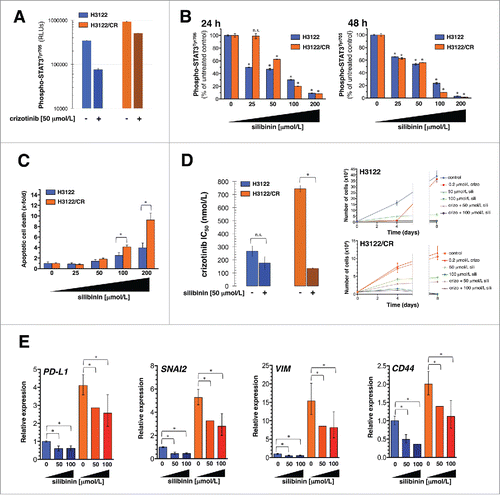Figures & data
Figure 1. Silibinin reverts STAT3-driven acquired resistance to crizotinib in ALK- rearranged NSCLC cells. (A) H3122 and H3122/CR cells were treated with 0.2 μmol/L crizotinib for 48 h. Whole cell lysates were subjected to phospho-STAT3Tyr705 ELISA. Results are expressed in relative light units (RLU) and represent the mean (columns) ± SD (bars) of 2 independent experiments performed in duplicate. (B) H3122 and H3122/CR cells were treated with graded concentrations of silibinin for 24 and 48 h. Whole cell lysates were subjected to phospho-STAT3Tyr705 ELISA. Results are expressed as the % of phospho-STAT3Tyr705 expression relative to untreated controls and represent the mean (columns) ± SD (bars) of 2 independent experiments performed in duplicate (n.s., non-significant differences were identified by ANOVA followed by Scheffé's multiple contrasts; *P < 0.01 relative to control cells by ANOVA followed by Scheffé's multiple contrasts) (C) Quantification of apoptosis-related cell death in H3122 and H3122/CR cells in response to 48 h treatment with graded concentrations of silibinin was determined as described in “Materials and methods.” Results are shown as mean (columns) ± SD (error bars) from at least 2 experiments in which duplicate wells were analyzed (*P < 0.01 relative to control cells by Student's t test for paired values) (D) Left. Cell viability of H3122 and H3122/CR cells cultured with graded concentrations of crizotinib was assessed using an MTT assay. Concentrations causing 50% reduction in cell viability (IC50 values) were calculated in the absence or presence of 50 μmol/L silibinin (n.s., non-significant differences were identified by Student's t test for paired values; *P < 0.01 relative to control cells by Student's t test for paired values). Right. H3122 and H3122/CR cells were plated in 24-well plates at 5,000 cells/well and treated with crizotinib, silibinin or crizotinib plus silibinin as specified. The data presented are mean of number cells × 104/well (columns) ± SD (bars). All assays were performed at least 2 times in triplicate. (E) Total RNA from H3122 and H3122/CR cells cultured in the absence or presence of graded concentrations of silibinin was characterized in technical triplicates for the relative abundance of PD-L1, SNAI2 (SLUG), VIM, and CD44. The transcript abundance was calculated using the delta Ct method and presented as fold-change vs. basal expression in H3122 parental cells. *P < 0.01 relative to untreated control cells by ANOVA followed by Scheffé's multiple contrasts.

